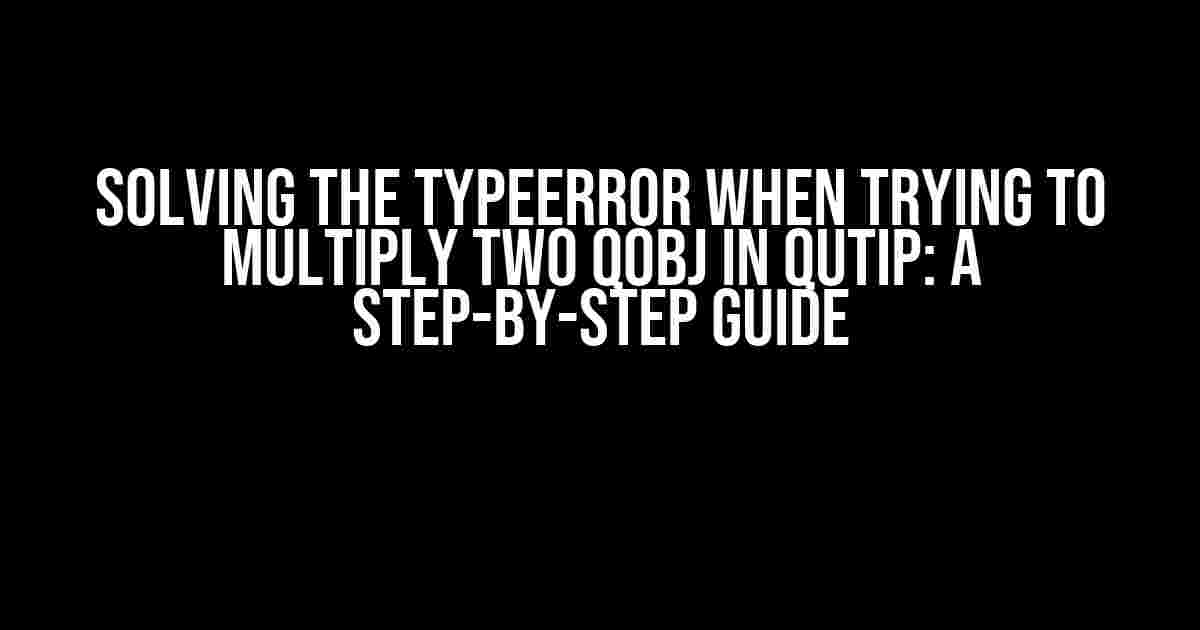If you’re reading this article, chances are you’ve encountered the frustrating TypeError when attempting to multiply two Qobj elements in Qutip. Don’t worry, you’re not alone! In this comprehensive guide, we’ll walk you through the causes, explanations, and most importantly, the solutions to this pesky error. By the end of this article, you’ll be multiplying Qobj elements like a pro!
What is Qutip and Qobj?
Before we dive into the error, let’s quickly cover the basics. Qutip (Quantum Toolbox in Python) is an open-source software framework for simulating the dynamics of quantum systems. It provides an efficient and flexible way to create, manipulate, and analyze complex quantum systems. Qobj (Quantum Object) is a fundamental data structure in Qutip, representing a quantum system, operator, or state.
The TypeError: What’s Causing It?
The TypeError occurs when Qutip can’t perform the multiplication operation between two Qobj elements. This error often stems from one of the following reasons:
- Incompatible dimensions: The number of columns in the first Qobj doesn’t match the number of rows in the second Qobj.
- Different data types: One or both of the Qobj elements are not of the correct data type (e.g., trying to multiply a ket with an operator).
- Non-numeric data: One or both of the Qobj elements contain non-numeric data, preventing the multiplication from taking place.
Case Study: A Simple Example
Let’s create a simple example to illustrate the TypeError:
import qutip
# Create two Qobj elements
a = qutip.ket('0')
b = qutip.ket('1')
# Attempt to multiply a and b
result = a * b
Running this code will result in a TypeError, as Qutip doesn’t allow direct multiplication between two ket states.
Solving the TypeError: Conversion and Dimension Checks
To resolve the TypeError, you need to ensure the following:
- Convert to a compatible data type: Use the `to` method to convert one or both Qobj elements to a compatible data type (e.g., operator, state, or superoperator).
- Check dimensions: Verify that the number of columns in the first Qobj matches the number of rows in the second Qobj.
import qutip
# Create two Qobj elements
a = qutip.ket('0')
b = qutip.ket('1')
# Convert a to an operator and check dimensions
a_op = a.to('op')
b_op = b.to('op')
print(a_op.dims, b_op.dims)
# Multiply a and b as operators
result = a_op * b_op
In this revised example, we convert both kets to operators using the `to` method, ensuring compatibility for multiplication. We also print the dimensions to verify that they match.
Common Scenarios and Solutions
Let’s explore some common scenarios where the TypeError may occur and provide solutions:
| Scenario | Error Cause | Solution |
|---|---|---|
| Multiplying two kets | Incompatible data types | Convert one or both kets to operators using the to method. |
| Multiplying a ket with an operator | Incompatible dimensions | Verify the number of columns in the ket matches the number of rows in the operator. |
| Multiplying two operators with different dimensions | Incompatible dimensions | Verify the number of columns in the first operator matches the number of rows in the second operator. |
| Multiplying a superoperator with a state | Incompatible data types | Convert the state to a superoperator using the to method. |
Best Practices to Avoid the TypeError
To avoid the TypeError altogether, follow these best practices:
- Verify data types: Always check the data types of your Qobj elements before performing operations.
- Check dimensions: Ensure the number of columns and rows match for compatible operations.
- Use the `to` method: Convert Qobj elements to compatible data types when necessary.
- Consult the Qutip documentation: Familiarize yourself with the Qutip documentation and API to ensure you’re using the correct methods and data types.
Conclusion
In conclusion, the TypeError when trying to multiply two Qobj elements in Qutip can be resolved by understanding the causes, converting to compatible data types, and checking dimensions. By following the step-by-step guide and best practices outlined in this article, you’ll be well-equipped to tackle even the most complex quantum simulations. Happy computing!
Still encountering issues? Leave a comment below, and we’ll be happy to help you troubleshoot!
Frequently Asked Question
Got stuck with TypeError when trying to multiply two Qobj in Qutip? Don’t worry, we’ve got you covered!
Why do I get a TypeError when trying to multiply two Qobj in Qutip?
This error usually occurs when you try to multiply two Qobj objects with different dimensions. Make sure to check the dimensions of your Qobj objects and ensure they are compatible for multiplication.
How do I check the dimensions of my Qobj objects?
You can check the dimensions of your Qobj objects by using the dims attribute. For example, if you have a Qobj object named ‘ops’, you can check its dimensions by calling ops.dims.
What if my Qobj objects have the same dimensions but I still get a TypeError?
Even if your Qobj objects have the same dimensions, you might still get a TypeError if they represent different types of operators (e.g., operators and superoperators). Make sure to check the type of your Qobj objects and ensure they are compatible for multiplication.
Can I multiply a Qobj object with a scalar?
Yes, you can multiply a Qobj object with a scalar. In fact, Qutip allows you to multiply Qobj objects with scalars, which is useful for scaling operators. Just make sure the scalar is a numerical value.
Where can I find more information about Qutip and Qobj objects?
You can find more information about Qutip and Qobj objects in the official Qutip documentation and tutorials. The Qutip community is also very active, so you can ask for help on forums or StackOverflow.
